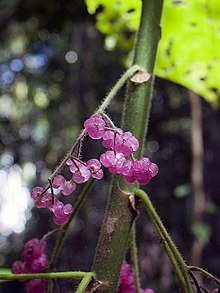Australian nettle
| Australian nettle | ||||||||||||
|---|---|---|---|---|---|---|---|---|---|---|---|---|

Dendrocnide moroides |
||||||||||||
| Systematics | ||||||||||||
|
||||||||||||
| Scientific name | ||||||||||||
| Dendrocnide moroides | ||||||||||||
| ( Wedd. ) Chew |
The Australian nettle ( Dendrocnide moroides ), also called Gympie , is a plant species from the genus Dendrocnide in the family of the nettle family (Urticaceae) native to Australia . It grows as a shrub or tree and has dangerous stinging hairs .
Distribution and location
The Australian nettle is common in Australia , especially Queensland . It is also common in the Moluccas and Indonesia . It grows in tropical rainforests , along roadsides and stream banks.
description
The Australian nettle grows as a shrub or tree and reaches heights of one to three meters, in exceptional cases a little more. The entire plant is dense and downy hairy and densely covered with stinging hairs .
Their leaves are shield-like, slightly heart-shaped, pointed and finely serrated. They are similar in shape to that of the linden tree . The fluffy hairy leaf blades are 12 to 22 inches long and 11 to 18 inches wide. They have six to eight pairs of leaf veins , with the basal pair clearly emerging. The petiole is between 10 and 18 centimeters long and has 1 centimeter long stipules .
The Gympie is single sexed ( monoecious ). The inflorescence is branched and reaches a length up to 15 centimeters and up to 8 centimeters wide. The flower stalks are up to 1.5 millimeters long. The small flowers each have four tepals . The male flowers have stamens 0.75 millimeters long . The female flowers have a 0.5 millimeter long ovary and a 2 millimeter long stigma . The closing fruits are egg-shaped, about 2 millimeters long and 1.5 millimeters wide. They are enclosed by the bracts .
toxicity
The stinging hairs are filled with a poison which, when touched, can cause severe itching to severe burning pain in humans, which can last a few days, in individual cases up to several months. The stinging hairs penetrate almost all fiber-based clothing, which is why you can only protect yourself against them to a limited extent. The plant doesn't even have to be touched directly to feel the toxicity, as stinging hairs continuously fall off the plant. After spending around an hour near a plant, sneezing attacks may occur. In the event of skin contact with the stinging hair, the removal of those with hair wax strips has proven itself. Many native Australian animals are insensitive to this plant and some even eat it.
Moroidin is a substance that was first isolated from the leaves of the Australian nettle. Structurally, it is a bicyclic octapeptide . It is responsible for the long-lasting pain after contact with the spines of the plant. In addition, Moroidin is chemically relatively stable, so that even dried leaves can sting and cause pain for years. The substance contains an unusual CN bond between tryptophan and histidine .
Web links
- Flora of Australia Volume 3 1989, ABRS / CSIRO
- Department of Environment and Conservation (NSW). Gympie Stinger
literature
- M. Hurley. Growth dynamics and leaf quality of the stinging trees Dendrocnide moroides and Dendrocnide cordifolia (Family Urticaceae) in Australian tropical rainforest: implications for herbivores . Australian journal of Botany 48, 2000.
- Contact poisonous plants of the world . http://mic-ro.com/plants/index_de.html#Dendrocnide%20excelsa (Version: February 20, 2015)

